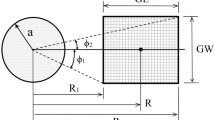Abstract
Choosing the right strain gage for a measurement application requires selecting gages with the right characteristics for the job. In general, the strain gage is to be used to measure the strain at the center of the gage, but it inherently underestimates the peak strain when it is mounted in high stress gradient areas. This paper concerns itself with the averaging effects of a strain gage along gage filaments. The approach is unconventional in dealing with the orientation and size of the gage. The results provide insight into the averaging effect and selecting gages for measuring strains in areas of steep strain gradients. Dimensionless curves which can be used to estimate errors as well as enhance hole-drilling method results are presented. Practical recommendations are made for selecting gages for high strain gradient measurements.
Similar content being viewed by others
References
J. W. Dally and R. J. Sanford, Strain-gage methods for measuring the opening-mode stress-intensity factor, KI, Experimental Mechanics, 27 (1987) 381–388.
J. R. Berger and J. W. Dally, An overdeterministic approach for measuring KI using strain gages, Experimental Mechanics, 28 (1988) 142–145.
J. R. Berger and J. W. Dally, An error analysis for a single strain-gage determination of the stress-intensity factor K I, Experimental Techniques, 12 (1988) 31–33.
N. T. Younis and J. Mize, Discrete averaging effects of a strain gage at a crack tip, Engineering Fracture Mechanics, 55 (1996) 147–153.
P. R. Marur and H. V. Tippur, A strain gage method for determination of fracture parameters in bimaterial systems, Engineering Fracture Mechanics, 64 (1999) 87–104.
H. Sarangi, K. S. Murthy, and D. Chakraborty, Radial locations of strain gages for accurate measurement of mode I stress intensity factor, Materials & Design, in press.
S. Y. Zhang, G. Prater, Jr., A. M. Shahhosseini and G. M. Osborne, Experimental validation of structural gage sensitivity indices for vehicle body structure optimization, Experimental Techniques, 32 (2008) 51–54.
Strain Gage Selection, Criteria, Procedures, Recommendations. Tech. Note TN-505-3, Measurements Group, Inc., Raleigh, North Carolina, USA.
J. Chen, Y. Peng and S. Zhao, Comparison between grating rosette and strain gage rosette in hole-drilling combined systems, Optics and Lasers in Engineering 47 (2009) 935–940.
P. Barsanescu and P. Carlescu, Correction of errors introduced by hole eccentricity in residual stress measurement by the hole-drilling strain-gage method, Measurement, 42 (2009) 474–477.
P. Trench, E. G. Little, D. Tocher, P. O’Donnell and V. Lawlor, The performance of three-dimensional strain rosettes evaluated when embedded into a sphere, Strain, 45 (2009) 149–159.
J. Pople, Error in strain measurement-the human factor (or how much do I contribute?), Experimental Techniques, 8 (1984) 34–38.
C. C. Perry, The resistance strain gage revisited, Experimental Mechanics, 24 (1984) 286–299.
P. Cappa, Random errors caused by temperature in magnitude of principal strains evaluated with 3-element strain gauge rosettes, Strain, 25 (1989) 139–144.
D. Zubin, Theoretical design of calibration beams for strain gauge factor measuring apparatus, Strain, 34 (1998) 99–107.
P. Litos, M. Svantner and M. Honner, Simulation of strain gauge thermal effects during residual stress hole drilling measurements, The Journal of Strain Analysis for Engineering Design, 40 (2005) 611–619.
M. Robinson, Strain Gage Materials Processing, Metallurgy, and Manufacture, Experimental Techniques, 30 (2006) 42–46.
J. W. Dally and W. F. Riley, Experimental stress analysis, McGraw-Hill, New York, USA (1991).
S. Swamy, M. V. Srikanth, K. S. R. K. Murthy and P. S. Robi, Determination of mode I stress intensity factors of complex configurations using strain gages, Journal of Mechanics of Materials and Structures, 3 (2008) 1239–1255.
Author information
Authors and Affiliations
Corresponding author
Additional information
This paper was recommended for publication in revised form by Associate Editor Jooho Choi
N. T. Younis received his Ph.D. degree from Iowa State University, USA, in 1988. He is currently a Professor of Mechanical Engineering at Indiana University — Purdue University Fort Wayne (IPFW). His research interests include solid mechanics, experimental stress analysis, and experimental fracture mechanics.
Rights and permissions
About this article
Cite this article
Younis, N.T., Kang, B. Averaging effects of a strain gage. J Mech Sci Technol 25, 163–169 (2011). https://doi.org/10.1007/s12206-010-1020-1
Received:
Revised:
Accepted:
Published:
Issue Date:
DOI: https://doi.org/10.1007/s12206-010-1020-1




